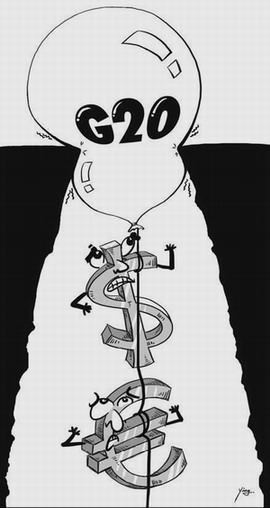Euro-paralysis at G20 summit
Updated: 2011-11-09 08:03
By Dan Steinbock (China Daily)
|
|||||||||||
|
 |
As the eurozone battleground expands from Greece to Italy, G20 must achieve in the future what the Cannes summit could not. Before the G20 summit in Cannes, French President Nicolas Sarkozy, along with German Chancellor Angela Merkel, had hoped to tout the merits of the recent eurozone deal and to return his original ambitious agenda for the G20.
All that fell apart with political turmoil caused by Greek Prime Minister George Papandreou's decision to call a referendum on Greece's membership of the euro, which he later reversed, and a confidence vote, which he then survived.
After two years of turmoil, European leaders have failed to contain the eurozone debt crisis. Greece remains a problem, but Italy could crash the euro.
In late October, the eurozone summit agreed on a "comprehensive plan," which, in fact, was partial, but initially caused market euphoria. With their deal, the eurozone leaders hoped to achieve three goals:
To expand the liquidity facility from the current 440 billion euros ($610 billion) to 1-2 trillion euros ($1.4-$2.8 trillion). Instead, the current deal will use leverage, which may contribute to the turmoil in the future.
To recapitalize the "systemically critical" euro banks by 100-110 billion euros ($140-$155 billion). In reality, however, 70 major euro banks must raise 106 billion euros ($150 billion) by mid-2012, which may be challenging because the region may already be in a recession.
To increase the Greek debt reductions from the current 21 percent to 50 percent. The second Greek bailout plan, which cost 130 billion, may be back on track for now. But Greece alone will consume at least 500 billion euros ($700 billion) in the 2010-2020 period to avoid default.
Meanwhile, other eurozone challenges - such as misguided fiscal policies, inadequate monetary policies (which the new European Central Bank chief Mario Draghi is finally trying to change), the toxic assets of the European Central Bank, inadequate structural reforms and growth policies - continue to simmer.
As European leaders failed to defuse the problems, they turned to the G20 and the BRICS alignment (China, India, Brazil, Russia and South Africa). In Cannes, however, they failed to get easy money from the G20, including the BRICS.
The euro leaders could have facilitated BRICS investment into the eurozone in several ways:
By making it easier for BRICS companies and investors to acquire hard assets, by accelerating reforms in international organizations (World Trade Organization, International Monetary Fund and World Bank) in which the Europeans are over-represented and the BRICS group remains under-represented and by recognizing China as a market-oriented economy ahead of the WTO's scheduled date for doing so in 2016.
Instead, the BRICS alignment was asked to buy the kind of eurozone financial paper that the United States, Japan, and the Europeans themselves refuse to touch. Certainly, BRICS economies would like to contribute more to the eurozone, which is a vital trading and high-tech partner, but they can do so only after the Europeans can stand on their own.
So what next? As the markets' unease will deepen, the Europeans will struggle for a bigger liquidity facility. The recapitalization of the major banks will be debated passionately. The Greek turmoil will continue because a unity government, or cooperation between Papandreou's Socialists and opposition leader Antonis Samaras' conservatives, is easier said than done.
In the past, the eurozone's problems were resolvable because the peripheral countries - Greece, Ireland and Portugal - each represented less than 3 percent of the eurozone economy. But if Spain or Italy, the two major "too big to fail" economies, fail to raise money at reasonable interest rates, the G20 will be forced to lead a coordinated response to avoid the adverse consequences on the world economy.
True, Italy's Prime Minister Silvio Berlusconi claimed there was no crisis in Italy. But even he had to accept a highly intrusive IMF monitoring of his government's promised reforms. That, however, is far from enough.
As in the case of the small euro countries, bailing out Spain and Italy would require covering their public financing requirements for three years. The associated loans would amount to about $2.1 trillion. If the IMF were to fund one-third of the total, as it did in the case of the small peripheral countries, its share would amount to about $700 billion, almost twice the current new lending capacity.
In turn, the eurozone countries would have to raise $1.4 trillion, which exceeds the available capacity of the current rescue fund by more than $1 trillion.
Unfortunately, even if the bailout were possible, any sudden stop of financing to Spain and Italy would cause a severe recession in these major economies and a spillover effect on the rest of Europe, the US and the BRICS economies.
With $850 billion in direct exposure and an additional $1.8 trillion in indirect exposure (that is, derivative contracts and guarantees), American banks, too, would be in harm's way.
Such developments would have adverse consequences worldwide. In the US, the "Lehman episode" took months to overcome but in the eurozone, it would require years. The stakes are higher: In the US, the subprime mortgage market peaked at $1-$1.5 trillion, whereas the outstanding debt of peripheral Europe amounts to $4.6 trillion.
In the coming months, the succession of the eurozone challenges - whether they prove manageable or disorderly - will compel the G20 to make the difficult decisions that the eurozone continues to avoid.
The author is research director of international business at India China and America Institute, an independent think tank in the US, and visiting fellow at Shanghai Institutes for International Studies.








